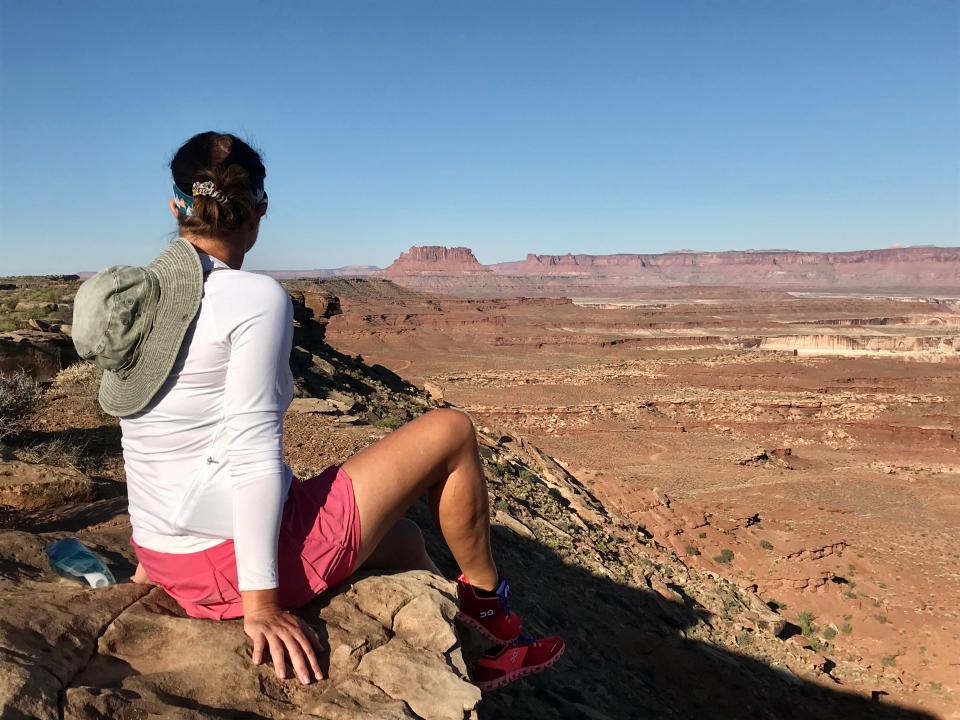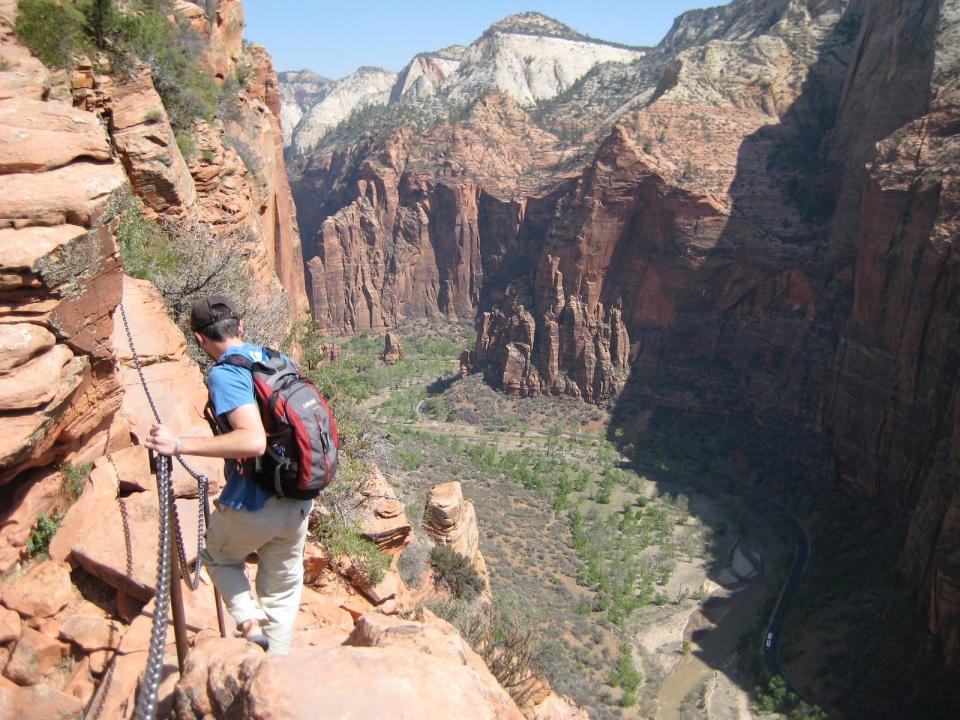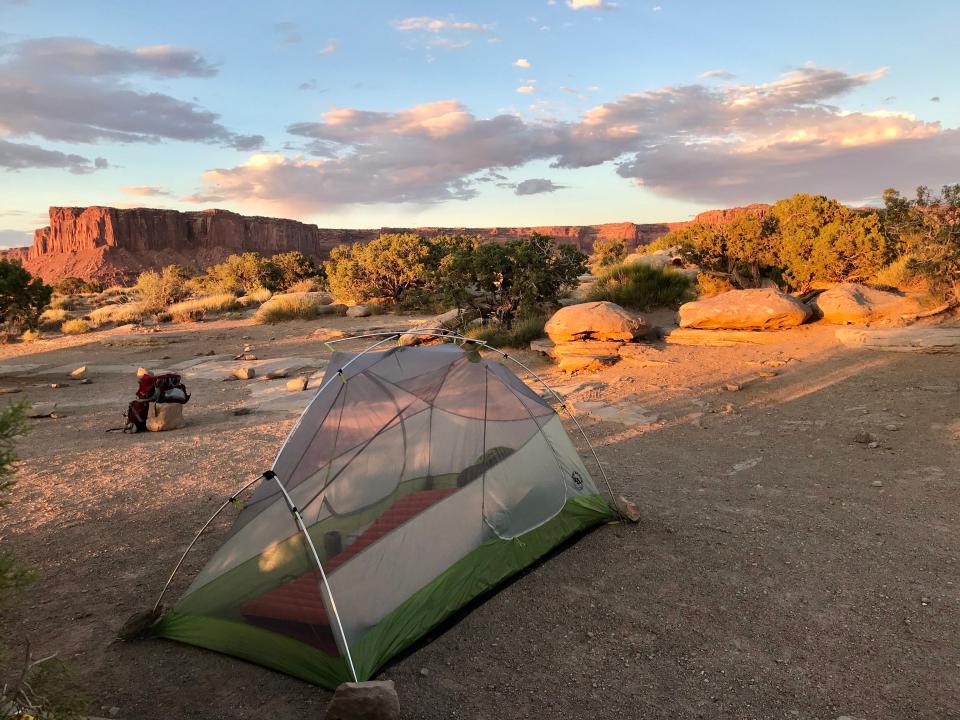Finding social distance measured in miles in Utah's 'Mighty 5' national parks
We were one-third of the way into the 6-mile hike and about a third of the way down the canyon wall’s thousand-foot descent when doubt began to choke my breath like the 100-degree heat radiating off the desert rocks and to pull at my shoulders and hips like the 40-pound pack strapped there.
My wife, Lori, always game for the next adventure, looked to me, trusting that the path would get easier as I’d promised. But I didn’t know, not for sure anyway. And I voiced the question all hikers dread:
“Should we turn back?”
After four months as virtual shut-ins during the coronavirus pandemic, we’d come to southern Utah seeking a balance between the open spaces we craved and secure measures against the new coronavirus. While traveling by air represented a calculated risk, we found what we sought — and so much more — in the state’s “Mighty Five” national parks: Arches, Bryce Canyon, Canyonlands, Capitol Reef and Zion.
What to know before you go: Visiting a reopened national park during the pandemic

Over the course of 10 days, we peered through a dozen sandstone arches and bridges that stood in defiance of the laws of gravity; witnessed a flash flood that sent torrents of chocolate-colored water pouring down cliff faces from peaks of 6,000 feet; disappeared into a labyrinth of sandstone hoodoos aligned like an army of prairie dogs peeking from their burrows; hiked upstream through a (mostly) shallow river that had carved a narrow canyon; and discovered social distancing measured not by just 6 feet — but by 6 miles.
But first, we had to get down this canyon wall.
Visiting Utah’s five national parks is a commitment of both research and time. The closest major airport is in Las Vegas, less than a three-hour drive to Zion. Reaching the other four parks means a combined thousand-mile journey and at least 15½ hours in the car. Starting in Salt Lake City would save about a hundred miles and an hour. Buying an $80 annual pass for a single-vehicle entry will save on fees, which top out at $35 for a week’s pass at Zion, bottom out at $20 to drive the scenic route at underrated Capitol Reef, and are $30 apiece at the other three parks.
You can plan a visit as strenuous as ours or as easy as, well, a stroll in the park. Either way, do your homework before setting out; the response to COVID-19 imposed near-daily changes. Check in with rangers on site for anything more challenging than walks on maintained trails. Double check access to campgrounds and backcountry camping permits. They were unavailable in some parks, while others had one but not the other, and lodges that normally offered a taste of rustic elegance in their dining rooms (think buffalo burgers and elk chili) were limited to takeout service only.
We pitied those in Zion, the region’s most popular park, who hadn’t studied. Park officials introduced on July 1 a ticketing system for the shuttle buses that run through the canyon’s most popular stretch. Those who failed to reserve a $1 ticket faced the daunting prospect of parking outside the restricted area and hoofing it as far into the 8-mile stretch as they could manage.

The best time to visit most of these parks is in the spring and fall, when the heat is not as oppressive. Circumstances dictated that our visit occur during some of the hottest weeks, so we tried to plan our longest hikes for morning or evening when conditions were kinder.
Even leaving after 4 p.m. on our first hike in Canyonlands, temperatures hovered in the triple digits, and the oven-like heat sucked the moisture from everything. On flat stretches, we stepped over desiccated Utah juniper trunks, gray as ash. The broom-like branches of Mormon tea shrubs crackled like twigs in a fire if you brushed past one. Rangers advise carrying at least a gallon of water a day per person, and in our caution we exceeded that — a weight of more than 8 pounds — and paid for it on the descent.
The narrow switchback trail at times demanded steep steps too long for Lori’s legs to reach easily. She wouldn’t hear of turning back though, her courage girded by the thought that the ascent in that heat might have proven even more difficult.
Sure enough, the path soon grew easier, and our packs felt lighter. Near the end of the hike, we rested on the edge of a narrow ridge, overlooking a landscape of sandstone boulders and the steep canyon walls that hemmed us in. In the distance, we spied the Green River, aptly named not only for the color of its waters but for the trees that grew along its banks. Signs of life were scarcer in our vicinity, and silence enveloped us. No bird song, not even a raven’s caw. No running water. No whistling of wind through leafy branches. That night, clear skies and a new moon exposed a canvas of so many stars I could navigate the campsite without a headlamp. We may have been the only mammals more than a foot high for miles.

As our time in Utah slipped away, we were sobered by thoughts of relinquishing these vast spaces of mind and distance for a world crowded with people and disheartening news.
I drew comfort by recalling a moment in Arches. We’d ascended more than 500 feet up a sandstone peak to view the Delicate Arch. The park’s largest and most-recognized freestanding arch appears impossibly fragile, though it has stood for eons.
A couple dozen tourists waited in a sliver of shade cast by the upper ridge to take photos beneath the 52-foot-high arch. No Disney-like rails or signs directed people; their line formed as naturally as the geological oddity they’d come to admire.
An older couple in need of a breather offered to take photos. While the woman operated the camera and smartphones, her husband directed the models. “Yellow Shirt, your face is in the shadow,” he told a girl of about 12. His wife coaxed different poses. “Move in closer,” she told a group of young adults. “Raise your hands wide,” she advised a family.
No one seemed hurried. No one cut the line. No one photobombed another’s souvenir shot. The shared good humor reminded me that for all the virtues we’d found in complete isolation during our escape, we’ll need social binds like these to deliver us from our troubled times.
This article originally appeared on USA TODAY: Utah national parks: Finding social distance in Arches, Zion, Mighty 5

